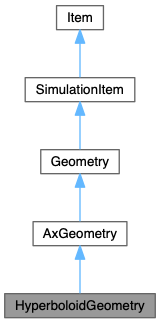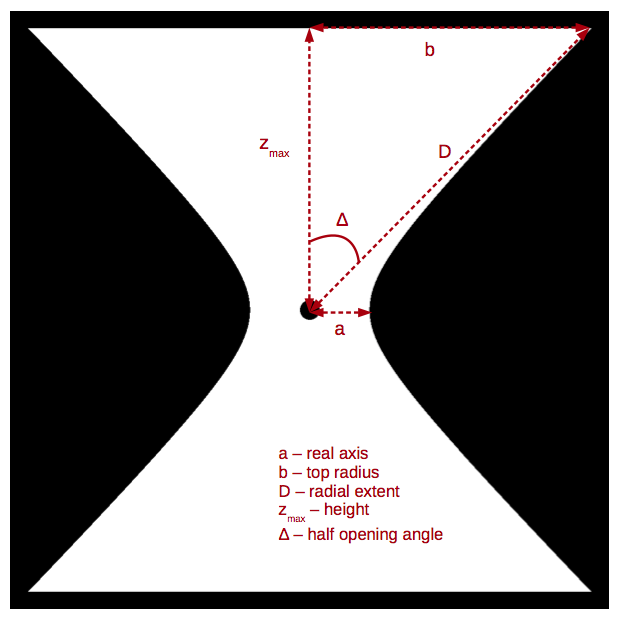#include <HyperboloidGeometry.hpp>

Public Member Functions | |
| double | cutoffRadius () const |
| double | density (double R, double z) const override |
| Position | generatePosition () const override |
| double | minRadius () const |
| double | openingAngle () const |
| double | radialExtent () const |
| double | realAxis () const |
| bool | reshapeInnerRadius () const |
| double | SigmaR () const override |
| double | SigmaZ () const override |
 Public Member Functions inherited from AxGeometry Public Member Functions inherited from AxGeometry | |
| virtual double | density (double R, double z) const =0 |
| double | density (Position bfr) const override |
| int | dimension () const override |
| virtual double | SigmaR () const =0 |
| double | SigmaX () const override |
| double | SigmaY () const override |
| virtual double | density (Position bfr) const =0 |
| virtual int | dimension () const =0 |
| virtual Position | generatePosition () const =0 |
| virtual double | SigmaX () const =0 |
| virtual double | SigmaY () const =0 |
| virtual double | SigmaZ () const =0 |
 Public Member Functions inherited from SimulationItem Public Member Functions inherited from SimulationItem | |
| template<class T > | |
| T * | find (bool setup=true) const |
| template<class T > | |
| T * | interface (int levels=-999999, bool setup=true) const |
| virtual string | itemName () const |
| void | setup () |
| string | typeAndName () const |
 Public Member Functions inherited from Item Public Member Functions inherited from Item | |
| Item (const Item &)=delete | |
| virtual | ~Item () |
| void | addChild (Item *child) |
| const vector< Item * > & | children () const |
| virtual void | clearItemListProperty (const PropertyDef *property) |
| void | destroyChild (Item *child) |
| virtual bool | getBoolProperty (const PropertyDef *property) const |
| virtual vector< double > | getDoubleListProperty (const PropertyDef *property) const |
| virtual double | getDoubleProperty (const PropertyDef *property) const |
| virtual string | getEnumProperty (const PropertyDef *property) const |
| virtual int | getIntProperty (const PropertyDef *property) const |
| virtual vector< Item * > | getItemListProperty (const PropertyDef *property) const |
| virtual Item * | getItemProperty (const PropertyDef *property) const |
| virtual string | getStringProperty (const PropertyDef *property) const |
| int | getUtilityProperty (string name) const |
| virtual void | insertIntoItemListProperty (const PropertyDef *property, int index, Item *item) |
| Item & | operator= (const Item &)=delete |
| Item * | parent () const |
| virtual void | removeFromItemListProperty (const PropertyDef *property, int index) |
| virtual void | setBoolProperty (const PropertyDef *property, bool value) |
| virtual void | setDoubleListProperty (const PropertyDef *property, vector< double > value) |
| virtual void | setDoubleProperty (const PropertyDef *property, double value) |
| virtual void | setEnumProperty (const PropertyDef *property, string value) |
| virtual void | setIntProperty (const PropertyDef *property, int value) |
| virtual void | setItemProperty (const PropertyDef *property, Item *item) |
| virtual void | setStringProperty (const PropertyDef *property, string value) |
| void | setUtilityProperty (string name, int value) |
| virtual string | type () const |
Protected Member Functions | |
| HyperboloidGeometry () | |
| void | setupSelfBefore () override |
 Protected Member Functions inherited from AxGeometry Protected Member Functions inherited from AxGeometry | |
| AxGeometry () | |
 Protected Member Functions inherited from Geometry Protected Member Functions inherited from Geometry | |
| Geometry () | |
| Random * | random () const |
| void | setupSelfBefore () override |
 Protected Member Functions inherited from SimulationItem Protected Member Functions inherited from SimulationItem | |
| SimulationItem () | |
| virtual bool | offersInterface (const std::type_info &interfaceTypeInfo) const |
| virtual void | setupSelfAfter () |
| virtual void | setupSelfBefore () |
 Protected Member Functions inherited from Item Protected Member Functions inherited from Item | |
| Item () | |
Private Types | |
| using | BaseType = AxGeometry |
| using | ItemType = HyperboloidGeometry |
Friends | |
| class | ItemRegistry |
The HyperboloidGeometry class is a subclass of the AxGeometry class and describes the geometry defined by a hyperboloid surface. It may be used to represent dusty outflows, extending vertically and then flaring towards the outside, asymptotically approaching a cone surface.

The current implementation allows only a constant density distribution bounded by the hyperboloid surface
\[ z=\frac{c}{a}\sqrt{\rho^2-a^2} \]
and two horizontal planes parallel to the xy plane, \(\pm z_{\text{max}}\). There are four free parameters describing this dust geometry: the radial extent \(D\), the half opening angle \(\Delta\), the real axis \(a\) and the minimum radius \(r_{\text{min}}\). The first two correspond to the length of the side and half opening angle of the cone to which the hyperboloid asymptotically approaches. The real axis is the radius of the hyperboloid base, i.e. the radius of the cross section of the hyperboloid with the xy plane. The minimum radius defines a spherical cavity centered on the coordinate origin. The hyperboloid formula contains two more parameters, the imaginary radius \(c\) and the radius of the hyperboloid top surface, but these values are determined by the other input parameters.
If the dusty system under consideration is surrounding an AGN or another source which is luminous enough to heat the dust to sublimation temperature, the inner radius should correspond to the sublimation radius which scale as \( r_{\text{min}} \propto L(\theta)^{0.5}\) (Barvainis, 1987, ApJ, 320, 537, eq (5)). If the primary source assumes anisotropic emission, the inner radius should follow the same dependence as the distribution of the primary source luminosity. Otherwise, dust temperature on the inner boundary of the geometry is very likely to be under- or over-estimated. Thus, if the NetzerAccretionDiskGeometry distribution is chosen to describe the primary source emission, it is recommended to enable the "reshape inner radius" option. The inner radius will then be set by the following formula:
\[ r_{\text{min}} \propto (\cos\theta\,(2\cos\theta+1))^{0.5}.\]
This should allow dust to approach all the way to the primary central source in the equatorial plane. However, due to the finite resolution of dust cells, it may happen that some of the innermost cells end up with unphysically high temperatures. For this reason, there is an additional input parameter, the cutoff radius \(r_{\text{cut}}\). The value of the cutoff radius is usually found after a few trial-and-error experiments by inspecting temperature distribution maps, until the inner wall of the geometry is at the expected sublimation temperature for a given dust population.
The total dust mass of the model corresponds to the mass of the original geometry, before the inner wall is reshaped to account for anisotropy. The deviation may or may not be significant, depending on the volume of the entire hyperboloid compared to the central cavity; it is the user's responsibility to check if it is within satisfactory limits.
This item type is displayed only if the Boolean expression "Level2" evaluates to true after replacing the names by true or false depending on their presence.
|
inlineprotected |
Default constructor for concrete Item subclass HyperboloidGeometry : "a hyperboloid geometry" .
|
inline |
This function returns the value of the discoverable double property cutoffRadius : "the inner cutoff radius of the hyperboloid" .
This property represents a physical quantity of type "length" .
The minimum value for this property is "[0" .
The default value for this property is given by the conditional value expression "0" .
This property is relevant only if the Boolean expression "reshapeInnerRadius" evaluates to true after replacing the names by true or false depending on their presence.
|
overridevirtual |
This function returns the density \(\rho\) at the cylindrical radius \(R\) and height \(z\). For the present geometry, it returns a constant density for positions inside the hyperboloid, and zero for positions outside the hyperboloid.
Implements AxGeometry.
|
overridevirtual |
This function generates a random position from the probability density \(p({\bf{r}})\, {\text{d}}{\bf{r}} = \rho({\bf{r}})\, {\text{d}}{\bf{r}}\). Since the current implementation allows only a constant density distribution, a random position can easily be constructed. The function repeatedly generates a uniform random position in the cylinder enveloping the geometry, and accepts the first position that happens to fall inside the nonzero-density region of the actual geometry.
Implements Geometry.
|
inline |
This function returns the value of the discoverable double property minRadius : "the radius of the central cavity" .
This property represents a physical quantity of type "length" .
The minimum value for this property is "]0" .
|
inline |
This function returns the value of the discoverable double property openingAngle : "the half opening angle of the hyperboloid" .
This property represents a physical quantity of type "posangle" .
The minimum value for this property is "]0 deg" .
The maximum value for this property is "90 deg[" .
|
inline |
This function returns the value of the discoverable double property radialExtent : "the radial extent of the hyperboloid" .
This property represents a physical quantity of type "length" .
The minimum value for this property is "]0" .
|
inline |
This function returns the value of the discoverable double property realAxis : "the real axis of the hyperboloid" .
This property represents a physical quantity of type "length" .
The minimum value for this property is "]0" .
|
inline |
This function returns the value of the discoverable Boolean property reshapeInnerRadius : "reshape the inner radius according to the Netzer luminosity profile" .
The default value for this property is given by the conditional value expression "false" .
|
overrideprotectedvirtual |
This function calculates some frequently used values, including the normalization factor \(A\), which is set by the normalization condition that total mass equals one, resulting in
\[ A=\frac{3}{2\pi}\frac{1}{z_{max}(2a^{2}+b^{2}-4 r^{3}_{min})}, \]
where \(b\) is the radius of the hyperboloid top surface (i.e. cross section with \( z_{\text{max}} \) plane), determined by the radial extent and the half opening angles.
Reimplemented from Geometry.
|
overridevirtual |
This function returns the radial surface density, i.e. the integration of the density along a line in the equatorial plane starting at the centre of the coordinate system,
\[ \Sigma_R = \int_0^\infty \rho(R,0,0)\,{\text{d}}r. \]
In the case of hyperboloid geometry with constant density this is simply
\[ \Sigma_R = 2A(a-r_{\text{min}}). \]
Implements AxGeometry.
|
overridevirtual |
This function returns the Z-axis surface density, i.e. the integration of the density along the entire Z-axis,
\[ \Sigma_Z = \int_{-\infty}^\infty \rho(0,0,z)\, {\text{d}}z. \]
For the hyperboloid geometry this integral is simply zero.
Implements Geometry.